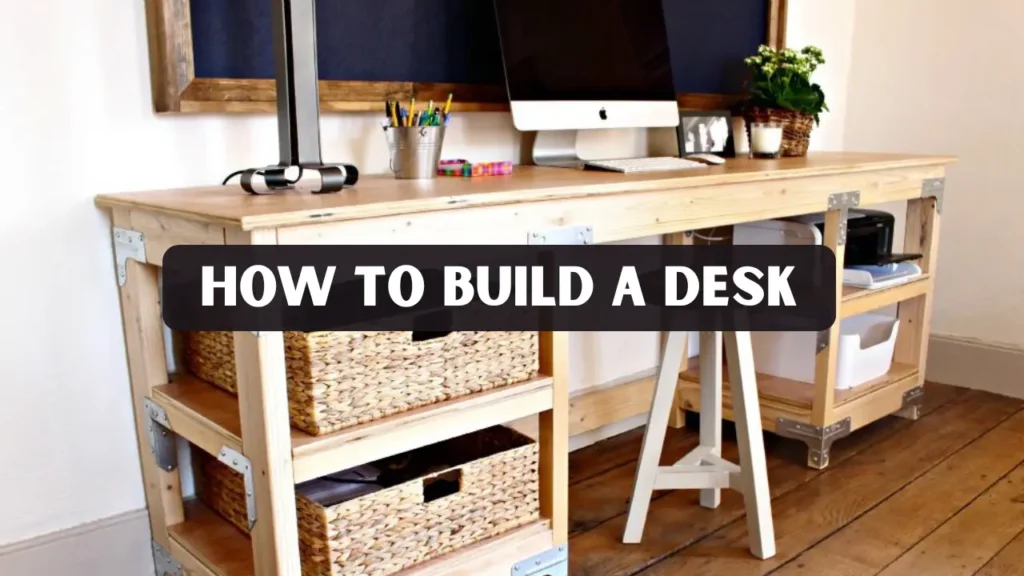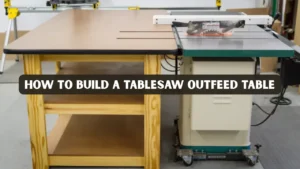Key Takeaways
- Learn how to build a desk that fits your unique workspace.
- Explore creative desk ideas to customize your design and style.
- Follow step-by-step instructions for cutting, assembling, and finishing.
- Gain real-world insights from practical case studies to enhance your woodworking skills.
Why You Should Build a Desk Yourself
Building a desk yourself allows you to create a workspace tailored to your room, style, and work habits. Store-bought desks often compromise on design, dimensions, or durability, while a DIY desk gives full control over materials, storage, and aesthetics.
Benefits of Building Your Desk:
- Custom size for your room and chair height
- Cost-effective compared to pre-made furniture
- Durable construction with solid wood
- Personalized design reflecting your workflow and style
- Satisfaction from completing a practical woodworking project
If you’re looking for desk ideas, building your own desk allows you to combine functionality and style perfectly suited to your workspace.
Tools and Materials Needed
Essential Tools
- Table saw or circular saw for precise cutting
- Drill with wood bits for pilot holes and fasteners
- Measuring tape, ruler, and carpenter’s square
- Clamps to secure parts while assembling
- Sandpaper or orbital sander for a smooth finish
- Screwdriver or power driver for screws
Recommended Materials
- Wood: Oak, maple, or pine for the desktop; plywood for budget-friendly options
- Hardware: Screws, brackets, and quality wood glue
- Finishing Supplies: Paint, stain, or polyurethane
- Optional Components: Keyboard tray, cable grommets, drawers, or shelves
Ensure your workspace is clean, flat, and well-lit. Proper preparation prevents mistakes and ensures a smooth building process.
Desk Ideas and Planning Your Design
Planning is essential when you build a desk that is both functional and stylish. Take into account your space, purpose, and design preferences to create the perfect workspace.
Desk Ideas to Inspire Your Build
- Corner Desk: Maximizes room space, perfect for small rooms.
- Floating Desk: Mounted to the wall, gives a modern, minimalist look.
- Standing Desk: Adjustable height options for ergonomic benefits.
- Gaming Desk: Wide surface and built-in cable management.
- Craft Desk: Extra storage for tools, supplies, or art projects.
Design Considerations:
- Height: 29–30 inches for comfortable seating
- Depth: 24–30 inches to fit monitors and keyboards
- Width: 48 inches for single setups, 60–72 for dual monitors
- Legroom: Minimum 25 inches clearance underneath
- Style: Modern, rustic, industrial, or customized to your decor
Sketching or using a 3D design tool helps visualize proportions and prevents material waste. Creative desk ideas can guide your layout while making your DIY desk unique.
Step by Step Guide
Step 1: Measure and Cut the Desktop
Cut the top panel to the desired size using a table saw or circular saw. Sand edges to remove roughness and splinters. Accuracy here ensures the rest of the desk fits perfectly.
Step 2: Construct the Frame
Cut four legs to your preferred height and attach aprons to form a rectangular frame. Secure with screws and wood glue, checking alignment with a carpenter’s square.
Stable legs and a sturdy frame are essential for durability.
Step 3: Attach the Desktop
Position the desktop on the frame, align edges, drill pilot holes, and fasten from underneath. Keep the surface level to avoid uneven weight distribution.
Step 4: Reinforce for Stability
When you build a desk, add a center stretcher or corner brackets for extra strength. For desks with drawers, attach rails and side panels at this stage to ensure stability and durability.
Step 5: Sand the Desk
Begin with 120-grit sandpaper, then progress to 220-grit for a polished surface. Always sand in the direction of the grain. Smooth surfaces improve finish adhesion and create a professional look.
Step 6: Finish Your Desk
Apply stain, paint, or polyurethane in thin, even coats. Let each coat dry completely before adding the next. Optional enhancements include:
- Cable grommets for tidy wire management
- Pull-out keyboard trays
- Storage drawers or shelves
Proper finishing protects the wood and elevates the desk’s appearance.
Tips for a Professional Finish
- Pre-drill holes to prevent splitting wood. This ensures clean screw insertion and maintains the integrity of the wood.
- Apply wood glue evenly on joints. Even application creates stronger bonds and prevents weak spots in the structure.
- Wipe off excess glue immediately. Removing residue prevents unsightly marks and ensures a smooth finish.
- Use two or more sealant coats for durability. Multiple coats provide long-lasting protection against scratches and moisture.
- Allow sufficient drying time between coats. Proper curing ensures a smooth, professional finish and prevents peeling or bubbling.
Following these tips ensures a smooth, professional-quality finish.
Common Mistakes to Avoid
- Incorrect measurements causing misalignment. Even small errors can make assembly difficult and result in an uneven desk.
- Skipping sanding or finishing steps. This can leave rough surfaces and reduce the desk’s durability and appearance.
- Rushing the stain or paint process. Uneven coats or streaks can ruin the final look and require rework.
- Ignoring ergonomic design. Poor desk height or layout can cause discomfort, strain, and reduced productivity.
- Overlooking reinforcements leading to wobbling. Lack of proper support may compromise stability and shorten the desk’s lifespan.
Avoiding these mistakes ensures a sturdy and functional desk.
Maintenance Tips for Longevity
- Dust weekly using a soft, damp cloth. This prevents buildup of dirt and grime that can scratch the surface over time.
- Avoid direct sunlight to prevent fading. Prolonged exposure can cause discoloration and weaken the wood finish.
- Use felt pads under legs to protect flooring. This also helps reduce noise when moving the desk and prevents scuff marks.
- Retighten screws periodically. Regular checks ensure the desk remains stable and prevents wobbling.
- Reapply finish annually to maintain look and protection. This helps preserve the wood’s natural beauty and prolongs the desk’s lifespan.
Regular maintenance extends the life of your desk and keeps it looking new.
Safety Guidelines
- Always wear eye protection and gloves. This protects you from flying debris and accidental cuts while working with tools.
- Keep your workspace clean. A tidy area reduces the risk of tripping or knocking over materials and tools.
- Clamp wood during cutting or drilling. Securing materials ensures precision and prevents slips that could cause injury.
- Turn off power tools when adjusting blades. This prevents accidental starts that could lead to serious injuries.
- Move slowly and deliberately to avoid accidents. Careful movements help maintain control and accuracy during every step of the build.
Following safety guidelines ensures a secure and efficient build.
Case Studies: Real-World Desk Builds
- Emma, a graphic designer, built a 60-inch oak desk to accommodate dual monitors. She added a pull-out keyboard tray and cable management holes. The desk cost under $200 and improved workflow efficiency.
- Liam, a college student, built a compact pine desk for his dorm room. He reinforced it with L-brackets and finished it with natural stain. The desk comfortably holds his laptop, books, and study materials, boosting productivity.
These examples showcase practical desk ideas that readers can adapt to their own projects.
Expert Advice for Material Selection
- Hardwoods like oak, maple, and walnut offer durability and a professional look. They are ideal for long-lasting desks that can withstand daily use without warping.
- Plywood or MDF is cost-effective for lightweight builds but requires proper finishing. Proper sealing and finishing prevent moisture damage and enhance appearance.
- Pocket-hole screws create strong, seamless joints. They provide a clean look while maintaining structural integrity without visible fasteners.
- Thin, even coats of sealant improve both durability and aesthetics. This technique protects the wood while highlighting its natural grain for a polished finish.
Attention to materials ensures your desk is not only functional but also visually appealing.
Conclusion
Building a desk is a rewarding project that combines creativity, skill, and practicality. By exploring desk ideas, you can build a desk perfectly suited to your room and workflow. Each step, from measuring and cutting to assembly, enhances your woodworking skills. A well-planned design ensures both functionality and a polished appearance.
Attention to detail during sanding, finishing, and reinforcing guarantees durability and style. Customizing features like drawers, keyboard trays, or cable management adds convenience. Whether for work, study, or hobbies, your DIY desk reflects personal style. With patience and precision, you can create a workspace that is both practical and visually appealing.
FAQs
What are some creative desk ideas for small spaces?
Corner desks, floating desks, and wall-mounted shelves maximize limited room while maintaining functionality.
How long does it take to build a desk?
Most DIY builds are completed in 1–2 days depending on design complexity and drying times.
Can I build it without power tools?
Yes, hand saws and manual drills can be used, though it requires more time and effort.
What wood is best for beginners?
Pine and birch plywood are lightweight, affordable, and easy to handle.
Is building a desk cheaper than buying one?
Yes, DIY builds typically cost half as much as comparable store-bought desks and offer complete customization.




